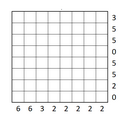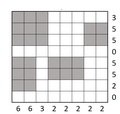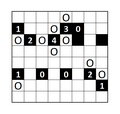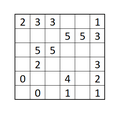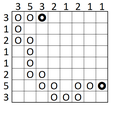Puzzles/Shading
Appearance
< Puzzles
Shade grid puzzles are named as such due to in order to solve the puzzle shading the grids is a must. Below are types of shading puzzles
Kuromasu
[edit | edit source]Rules
[edit | edit source]- Certain cells are shaded so that each number indicates total number of cells that are "visible"/ unshaded cells in the same row and column, including cells itself
- No cells with number can be shaded
- Shaded cells cannot touch except diagonally
- All unshaded cells must form a single continuous area, you can travel horizontal and vertically from cells to cells
-
Examples of solved Kuromasu
Clouds
[edit | edit source]Rules
[edit | edit source]- Shade rectangular group of cells so that each group is at least 2 cells wide and at least 2 cells tall ( > 2X2)
- Each shaded rectangular cannot touch at all even diagonally
- The number given is the number of shaded cells in each rows and columns
-
Cloud puzzles
-
Cloud solved puzzles
Light Up
[edit | edit source]Rules
[edit | edit source]- Place light bulbs in some empty cells so that each empty cells is illuminated
- Light bulbs illuminate every cell in their row and column until being blocked by black cell
- No light bulb can be illuminated by other light bulb
- Some black cells have number, corresponding to the number of touching, non diagonally cells
-
Example of empty puzzles
-
Example of solved puzzles
Mosaic
[edit | edit source]Rules
[edit | edit source]- Shade some grid cells, which may include the numbers printed on them
- A number in cell reveal the number of shaded touching cells, including touching diagonally and the cell itself
- The finished puzzle will reveal a simple picture
Gallery
[edit | edit source]-
Example of solved puzzles
Heyawake
[edit | edit source]Rules
[edit | edit source]- Shade some grid cells, so that no 2 shaded cells are adjacent (except diagonally) and unshaded cells forming single continuous area
- Any single horizontal or vertical group of unshaded cells cannot cross more than one bold line region
- Number cells may or may not be shaded but it always gives the precise amount of shaded cells inside the bold line region
-
Empty heyawake puzzles
-
Example of solved puzzles
Tapa
[edit | edit source]Rules
[edit | edit source]- Shade some cells to form contiguous shaded region
- Numbers in a cell reveal length of each group of touching shaded cells (Including diagonally touching cells)
- If there are more than one number in a cell, meaning there must be at least one unshaded cell
- Shaded cell cannot form 2X2 square or larger
-
Example of Tapa puzzles
-
Examples of Tapa solved puzzles
Minesweeper
[edit | edit source]Rules
[edit | edit source]- Place mines into empty cells in the grid
- Number in the cells meant that humber of mines touching the cells itself (including diagonally)
- Only one mine may be placed per cell
-
Example of Minesweeper puzzles
-
Example of solved Minesweeper puzzle
Snake
[edit | edit source]Rules
[edit | edit source]- Shade some cells to form a single snake that starts and ends at the given cells
- The "snake does not cross over itself
- The snake does not touch itself (even diagonally, except when turning cornet)
- Number outside the grid specify number of cells in row/column contain part of the snakes
-
Example of snake puzzle
-
Example of solved snake puzzle
Hitori
[edit | edit source]Rules
[edit | edit source]- Shade some cells so that no numbers repeat in any row of column
- Shaded cells cannot touch except diagonally
- All shaded cells must form a single unconnected region
-
Example of Hitori solved puzzles
Mochikoro
[edit | edit source]Rules
[edit | edit source]- Shade some cells so that every numbers in the puzzle remain as part of continuous unshaded rectangle of precisely the given cells
- Shaded cells cannot form areas larger than 2X2
- Not all unshaded rectangles are necessarily marked with numbers
- In this puzzle, rectangle can meant square too.
-
Example of solved puzzles
Star Battle
[edit | edit source]Rules
[edit | edit source]- Place stars in some cells so that each row , column and outlined region contains exactly two stars
- Stars cannot touch each other, not even diagonally
-
Example of Star Battle puzzles
-
Example of solved Star Battle puzzle



